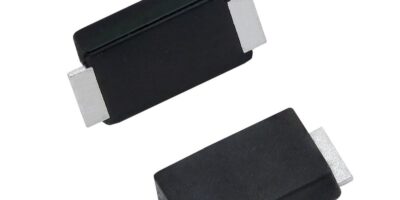Rectifiers in SlimSMAW package improve AOI, says Vishay Intertechnology
FRED Pt Ultrafast recovery rectifiers from Vishay Intertechnology now include 2A and 3A models in a SlimSMAW package.
The 100V and 200V devices are footprint-compatible with the SOD-128 package, while offering larger lead widths than the SlimSMA and also improve automated optical inspection (AOI), says the company.
Vishay Intertechnology has added eight 100V and 200V devices in the eSMP series SlimSMAW (DO-221AD) package with a low 0.9mm profile. They are footprint-compatible with the common SOD-128, but have larger lead widths than devices in the SlimSMA, for increased reliability, says the company.
The 2A and 3A rectifiers offer high current density and the wide leads are claimed to provide stronger adhesion to the PCB and improve AOI in automotive systems. FRED Pt Ultrafast technology enables fast recovery times down to 16ns at at temperature junction of 25 degrees C, reduced Qrr to 20 nC and soft recovery features over the 55 to 175 degrees C operating range.
The rectifiers are available in AEC-Q101 qualified versions and feature low forward voltage drop down to 0.69V, which reduces power losses and improves efficiency in high frequency inverters, DC/DC converters, freewheeling diodes, and power factor correction in automotive engine control units (ECU), anti-lock braking systems (ABS), and HID and LED lighting as well as telecomms and industrial power supplies.
The VS-2EYH01-M3, VS-2EYH01HM3, VS-2EYH02-M3, VS-2EYH02HM3, VS-3EYH01-M3, VS-3EYH01HM3, VS-3EYH02-M3 and VS-3EYH02HM3 rectifiers offer an MSL moisture sensitivity level of 1, per J-STD-020, LF maximum peak of +260 degrees C. The diodes are RoHS-compliant and halogen-free, and suitable for automated placement.
Samples and production quantities of the FRED Pt Ultrafast rectifiers are available now, with lead times of 14 weeks for large orders.
Vishay Intertechnology manufactures discrete semiconductors (diodes, MOSFETs, and infrared optoelectronics) and passive electronic components (resistors, inductors, and capacitors). These components are used in virtually all types of electronic devices and equipment, in the industrial, computing, automotive, consumer, telecommunications, military, aerospace, power supplies, and medical markets.




